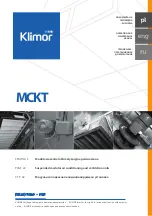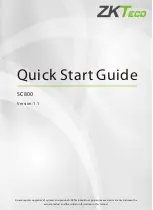
28
29
www.klimor.com
www.klimor.com
MCKT - SUSPENDED MODULAR AIR CONDITIONING AND VENTILATION UNITS
OPERATION AND MAINTENANCE MANUAL
4.5 MCKT Unit Operation with HPM Module
4.5.1 Operation in Heating Mode
In the counter-current cross-flow exchanger block the
air is preheated. Then, the air is referred to the heat
pump condenser, which constitutes the unit’s second
degree heating.
Assuming that the MCKT unit is going to work in out-
door temperatures of below -5ºC, it is necessary to use
third degree heating, i.e. a water or electrical heater,
which will ensure the required intake air temperature.
In outdoor temperatures of below -5ºC the coun-
ter-current cross-flow exchanger may frost over. In
this event the automation system will switch off the
heat pump, set maximum heating on the heater, and
reduce the unit’s performance.
Warm air removed from the room, when flowing
through the counter-current exchanger with the by-
pass on the intake side open, will cause the exchanger
to defrost quickly and return to regular operation.
If it is inadmissible to reduce the unit’s performance
for the time of the defrost process, it shall be neces-
sary to install a preheater before the counter-current
exchanger and maintain a temperature of 0ºC before
the unit. The unit operates with the preheater and
heat pump.
The unit is not fitted with preheaters. See more infor-
mation in documents concerning control of the MCKT
unit.
4.5.2 Operation in Cooling Mode
The counter-current cross-flow exchanger does not
work. The intake air flows through the exchanger by-
pass and is referred onto the heat pump system cool-
er, where its temperature becomes reduced.
4.6 Limitations and Requirements
It should be remembered that the heat pump system is
a form of heat recovery. It requires appropriate intake
and outlet air temperatures and quantities in order
to work correctly. The values given in Table No. 4 are
necessary for correct operation of the cooling system.
Low temperature of the air removed from the room
or its small amount in the winter season will result in
a pressure drop in the compressor’s suction part, thus
causing it to switch off. High temperature in the outlet
part or a small amount of air in the summer season will
result in increased pumping pressure, thus also causing
the compressor to switch off. Hence, in order for the
system to work properly it is vitally important to select
air temperature correctly and adjust the air network
appropriately.
5. Transport, Storage
5.1 General Requirements
MCKT units are delivered to the installation site in the
form of separate blocks together with a set of connect-
ing elements. They are secured with foil for transport.
Unloading from the transport vehicle and transport
to the building site is done manually with the use of
a pallet-lift truck or forklift truck. When transporting
the unit blocks, one should see to it that they are lifted
and lowered gently. MCKT unit modules should not be
transported and stored when they rest on one of the
sidewalls of the casing.
It is recommended that the modules be transported
on the wall opposite to the inspection panels (“on the
back”).
Immediately after delivery its completeness should be
checked.
Any damage caused as a result of improper transport
and storage shall not be covered by the manufacturer’s
warranty.
Storage conditions:
• maximum relative air humidity of <80% in a tempera-
ture of 20ºC
• temperature from -20ºC to 40ºC
• environment free of caustic dusts, gases and fumes and
chemically active substances with corrosive properties
5.2 Transport of MCKT-HPM heat pump module
Owing to the fastening of the cooling installation ele-
ments – operation, long-lasting transport and storage is
unacceptable in a position other than in DRAWING 05.
DRAWING 05:
Position of MCKT-HPM for operation and transport
In case of transport on site it is acceptable to lean the
section by 90º for a short time as in DRAWING 06.
DRAWING 06:
Acceptable position for short-lasting transport of MCKT-HPM
6. Installation of the Unit on Site
6.1 Location
The unit should be mounted in a way as to ensure con-
nection to outer installations (ventilation ducts, pipe-
lines, cable tracks), avoiding collision with inspection
panels. In order to facilitate assembly, operation and
servicing of the units and renewal of elements and
subassemblies in case of failure, it is necessary to main-
tain appropriate spaces between the servicing side
and fixed elements of the room’s development (walls,
load-bearing columns, binders etc.).
The above-mentioned spaces are also recommended
because of the outer sizes of the elements of the fit-
tings supplying the heaters and coolers, and should
not be smaller than 500mm.
6.2 Suspending the Unit
6.2.1 Compact Unit
The unit is to be suspended with the use of handles
mounted on the sides of the casing. A M8 threaded bar
is inserted into the lower part of the handle (U1) and a
nut with a washer is screwed on. Next, the bar is insert-
ed into the groove of the upper part of the handle (U2),
and at the same time they are joined together by push-
ing the U1 element into the U2 element at the bottom.
The use of M8 threaded bars enables easy and quick
suspension and levelling off of the particular modules
of the unit. The M8 threaded bars are not delivered. The
minimum retained distance of the upper surface of the
unit to the partition should be 20mm (DRAWING 07).
20
U2
U1
M8 BAR
DRAWING 07:
Suspending the MCKT unit in the compact version
6.2.2 Modular Unit
Modular units in intake or outlet systems should be
suspended, just like compact units, with the use of
handles mounted on the sides of the casings. The
modules are suspended independently. Prior to con-
nection, an adhesive seal should be stuck on the front
surface of one of them (unless it has been stuck in fac-
tory). The modules are to be bolted together using the
handles on which the units are hanging. They are to
be bolted together on both sides of the casing with
a double set of M6x60 bolts.
M6x60 BOLT CONNECTOR
DRAWING 08:
Suspending the MCKT unit in the modular version
Modular units in intake-outlet systems with cross-
flow exchanger are to be suspended with the use of
handles mounted on the sides of the casings.
The modules should be interconnected with the use
of four interior corners located on the front surfaces.
Remembering to place a seal on one of the front sur-
faces, we bolt together both modules with M6x16
bolts (DRAWING 09B). Adjacent modules, having
their sidewalls in contact, are to be bolted together
with M6x70 bolt connectors (DRAWING 09A). The
bolts should go through the corner openings and
through the casing. Connecting the casings should
be preceded by removal of interfering handles. Such
a system of two modules is to be suspended with the
use of the remaining four handles.
A
B
B
A
M6X70
BOLT
M6 NUT
M6 CONNEC
TOR
M6 WASHER
DRAWING 09:
Interior connections of modular unit (section of CPR
cross-flow exchanger and individual sections).
All the connecting elements: bolts, nuts and washers
are delivered in separate packaging (bags) with an
abridged assembly manual.
6.2.3 Modular Unit with HPM
Also intake-outlet systems with cross-flow exchanger
and heat pump are to be suspended with the use of
handles.
















































